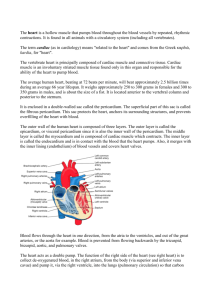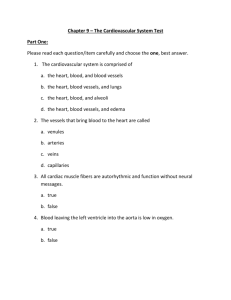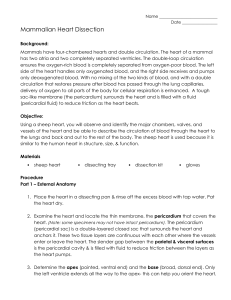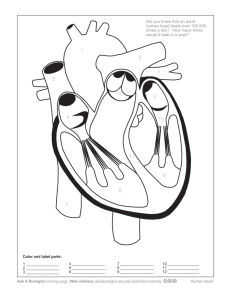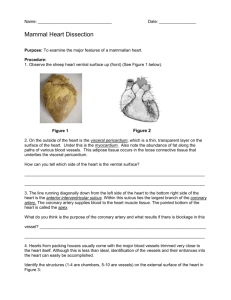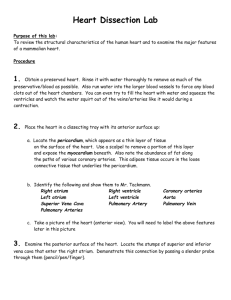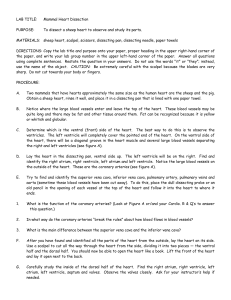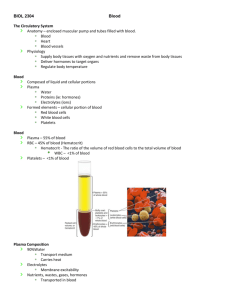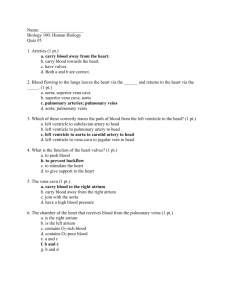Sheep Heart Dissection Lab: Anatomy & Physiology
advertisement
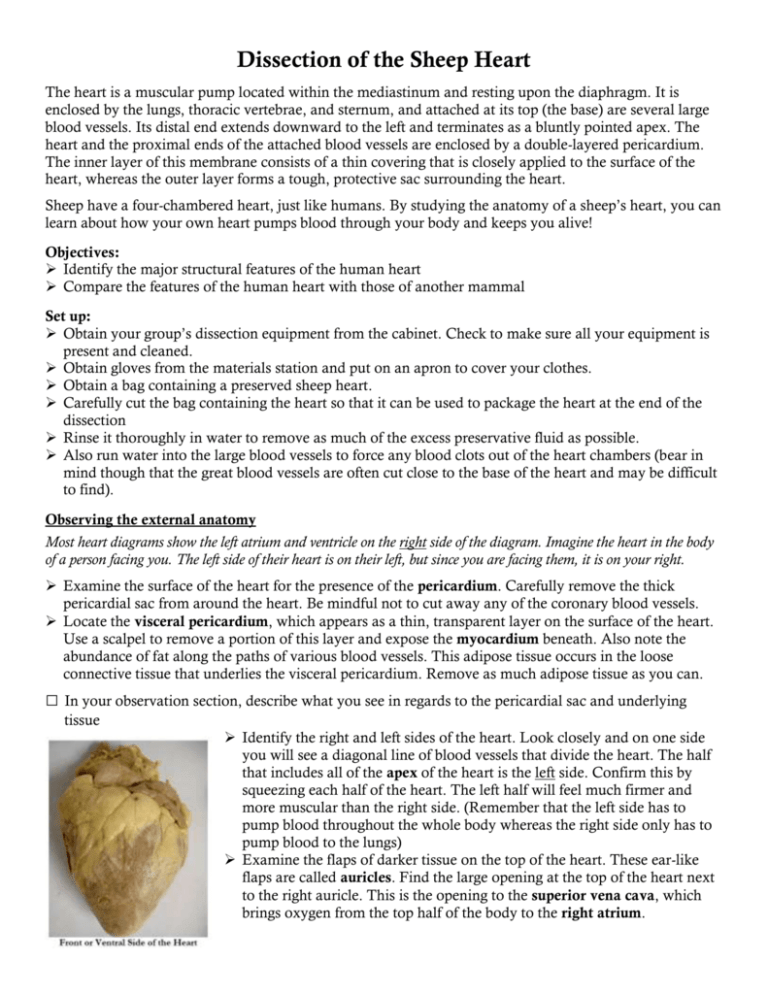
Dissection of the Sheep Heart The heart is a muscular pump located within the mediastinum and resting upon the diaphragm. It is enclosed by the lungs, thoracic vertebrae, and sternum, and attached at its top (the base) are several large blood vessels. Its distal end extends downward to the left and terminates as a bluntly pointed apex. The heart and the proximal ends of the attached blood vessels are enclosed by a double-layered pericardium. The inner layer of this membrane consists of a thin covering that is closely applied to the surface of the heart, whereas the outer layer forms a tough, protective sac surrounding the heart. Sheep have a four-chambered heart, just like humans. By studying the anatomy of a sheep’s heart, you can learn about how your own heart pumps blood through your body and keeps you alive! Objectives: Identify the major structural features of the human heart Compare the features of the human heart with those of another mammal Set up: Obtain your group’s dissection equipment from the cabinet. Check to make sure all your equipment is present and cleaned. Obtain gloves from the materials station and put on an apron to cover your clothes. Obtain a bag containing a preserved sheep heart. Carefully cut the bag containing the heart so that it can be used to package the heart at the end of the dissection Rinse it thoroughly in water to remove as much of the excess preservative fluid as possible. Also run water into the large blood vessels to force any blood clots out of the heart chambers (bear in mind though that the great blood vessels are often cut close to the base of the heart and may be difficult to find). Observing the external anatomy Most heart diagrams show the left atrium and ventricle on the right side of the diagram. Imagine the heart in the body of a person facing you. The left side of their heart is on their left, but since you are facing them, it is on your right. Examine the surface of the heart for the presence of the pericardium. Carefully remove the thick pericardial sac from around the heart. Be mindful not to cut away any of the coronary blood vessels. Locate the visceral pericardium, which appears as a thin, transparent layer on the surface of the heart. Use a scalpel to remove a portion of this layer and expose the myocardium beneath. Also note the abundance of fat along the paths of various blood vessels. This adipose tissue occurs in the loose connective tissue that underlies the visceral pericardium. Remove as much adipose tissue as you can. □ In your observation section, describe what you see in regards to the pericardial sac and underlying tissue Identify the right and left sides of the heart. Look closely and on one side you will see a diagonal line of blood vessels that divide the heart. The half that includes all of the apex of the heart is the left side. Confirm this by squeezing each half of the heart. The left half will feel much firmer and more muscular than the right side. (Remember that the left side has to pump blood throughout the whole body whereas the right side only has to pump blood to the lungs) Examine the flaps of darker tissue on the top of the heart. These ear-like flaps are called auricles. Find the large opening at the top of the heart next to the right auricle. This is the opening to the superior vena cava, which brings oxygen from the top half of the body to the right atrium. Stick a probe down the superior vena cava. You should feel it open into the right atrium. A little down and to the left of the superior vena cava there is another blood vessel opening. Insert your probe into this; it should also lead into the right atrium. This is the inferior vena cava, which brings blood from the lower tissues. You can also see another blood vessel next to the left auricle. This is a pulmonary vein that brings blood from the lungs into the left atrium. Sticking straight up from the center of the heart is the largest blood vessel you will see. This is the aorta, which takes oxygenated blood from the left ventricle to the rest of the body. The aorta branches into more than one artery right after it leaves the heart, so it may have more than one opening on your heart specimen. Look carefully at the openings and you should be able to see that they are connected to each other. Behind and to the left of the aorta there is another large vessel. This is the pulmonary artery which takes blood from the right ventricle to the lungs. Observing the Internal Anatomy Starting at the apex and moving towards the base, make a coronal (frontal) cut through the heart. Stop cutting when your scalpel reaches the top portions of the atria. Open the heart at the apex. Notice that the heart is made up of three histological layers: the epicardium (which is the same as the visceral pericardium), the myocardium (literally the “heart muscle”), and the endocardium (inside the heart). Locate the side with the thickest myocardial wall. This will orient you to the left side of the heart. You should see that there are spaces (or chambers) on the left and right sides of the lower heart. These are the left and right ventricles (“vent” referring to something coming out of the space, which is blood in this case). You should also see a thick structure dividing the two ventricles, the bulk of which is composed of cardiac muscle. This is the interventricular septum. The ventricles are divided from the chambers directly above them by atrioventricular (or AV) valves. These valves have flaps (or cusps) to which the chordae tendinea (or heart strings) attach. The left AV valve has two cusps, so it can be referred to as being a bicuspid valve. The right AV valve has three cusps, so it can be referred to as being a tricuspid valve. The chordae tendineae are anchored to the ventricular walls via papillary muscles. Locate the semilunar valves. Insert your probe into the pulmonary artery and see it come through to the right ventricle. Make an incision down through this artery and look inside it for three small membranous pockets. These form the pulmonary semilunar valve which prevents blood from flowing back into the right ventricle. Insert a probe into the aorta and observe where it connects to the left ventricle. Make an incision up through the aorta and examine the inside carefully for three small membranous pockets. These form the aortic semilunar valve which prevents blood from flowing back into the left ventricle. □ After finding all of the essential structures listed above, sketch what you see. Be sure to label all of the structures identified in the instruction section with bold print. Also include the right and left atria. □ In your observation section, be sure to discuss the following observations: a) Compare the thickness of the wall of the left ventricle with that of the right ventricle b) Compare the thickness of the aortic wall with that of the pulmonary trunk Clean Up Place the dissected heart as well as any tissue that has been removed back in the original bag that it came in. Discard of it in the trash can. Discard your gloves in a lined trash can. Wash, rinse, and thoroughly dry any tools and equipment used before returning your group’s equipment to the cabinet. Wipe down your lab station and return any other used materials to the materials station. *If I find that any of the tools are missing from your inventory or clean up is not properly completed, every member of your group will lose 10% of the practical points.* Analysis Questions 1. What is the significance of the difference in thickness of the ventricular walls? 2. Compare the function and structure of the tricuspid valve with that of the pulmonary valve. 3. Describe the function of the chordae tendinae and the papillary muscles. 4. Using words and arrows, list in order the major blood vessels, chambers, and valves through which blood must pass in traveling from a vena cava to the aorta.


